What Is Aeration?
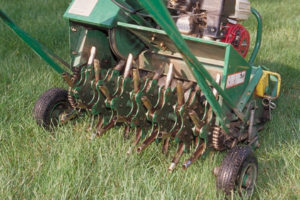
Aeration is the naturally occurring process of air exchange between the soil and its surrounding atmosphere. Practically speaking, aeration is the process of mechanically removing small plugs of thatch and soil from the lawn to improve soil aeration. This can be done in a number of ways, including coring, spiking or slicing. The aeration process is commonly called core aeration in the lawn care industry.
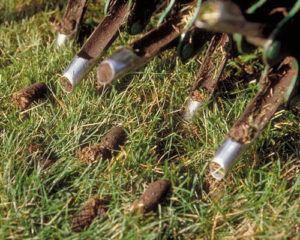
What are the Benefits of Aeration?
Core aeration helps the lawn’s health and vigor, and it reduces maintenance requirements. Listed below are the other benefits of core aeration.
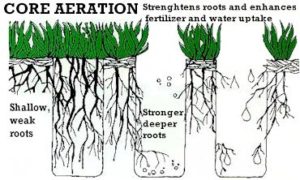
- Improved air exchange between the soil and atmosphere
- Enhanced soil water uptake
- Improved fertilizer uptake and use
- Reduced water runoff and puddling
- Improved turfgrass root system
- Reduced soil compaction
- Enhanced heat and drought stress tolerance
- Improved resiliency and cushioning
- Enhanced thatch breakdown
The depth and spacing of the core holes greatly influence the benefits obtained from aeration. In general, turf responds best when the core holes are close together and deep. The depth of the core hole depends on the weight of the equipment being used, as well as the soil structure in the lawn. For example, tines will penetrate sandy soils to a greater depth than heavy clay soils, such as those found throughout Delaware and Pennsylvania. Penetration is also better in moist soils than in dry soils. Closer core holes remove more soil, exposes more soil surface are for nutrient and water uptake, and relieves compaction more quickly.
Why is Aeration Necessary?

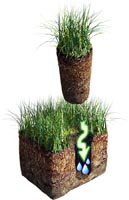 In most home lawns, the natural soil has been seriously disturbed by the building process. Fertile topsoil may have been removed or buried during excavation of the basement, leaving subsoil that is more compact, higher in clay content and less desirable for healthy lawn growth. These lawns need aeration to improve the depth and extent of turfgrass root systems and to improve nutrient and water use.
In most home lawns, the natural soil has been seriously disturbed by the building process. Fertile topsoil may have been removed or buried during excavation of the basement, leaving subsoil that is more compact, higher in clay content and less desirable for healthy lawn growth. These lawns need aeration to improve the depth and extent of turfgrass root systems and to improve nutrient and water use.
Intensively used lawns are exposed to stress from traffic injury. Walking, playing and mowing are forms of traffic that compact the soil and stress lawns. Rain and irrigation can also compact the soil, reducing the large air spaces where roots readily grow.
Compaction is greater on heavy clay soils than on sandy soils and is greatest in the top 1 to 1 ½ inches of soil. Aeration helps heavily used and compacted lawns by improving the depth and extent of the turfgrass root system, allowing better water and nutrient uptake, and speeding up thatch breakdown.
Most lawns are subject to thatch accumulation. If left unmanaged, thatch can lead to serious maintenance and pest problems. Core aeration breaks through the thatch layer and incorporates soil into the thatch. This increases the breakdown and reduces the accumulation of the thatch.
When should lawns be Aerated?
Core aeration is always beneficial to the lawn. Lawns growing on heavy clay soils or have been exposed to intense use benefit from annual aeration. Both spring and fall are ideal times to aerate cool-season grasses, such as tall fescue or Kentucky Blue Grass. Core aeration coordinated with fall fertilization enhances root growth responses and improves green-up and growth.
Although aeration is beneficial for lawns, it can open up spaces for weeds, such as crabgrass, to invade the lawn. It is best to coordinate the aeration before applying pre-emergent controls, as the process can reduce the effectiveness of the application, allowing for weeds and weed grasses to germinate. It is for this reason, we prefer to core aerate in the Fall, rather than the Spring.
What can you Expect?
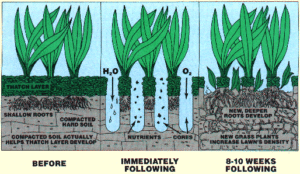 Immediately after aeration, your lawn will be dotted with small plugs pulled from the soil. Within a week or two, these plugs will break apart and disappear back into the lawn.
Immediately after aeration, your lawn will be dotted with small plugs pulled from the soil. Within a week or two, these plugs will break apart and disappear back into the lawn.
Within 7 to 10 days, the holes will be filled with white actively growing roots. These roots indicate that the turf is responding to the additional oxygen, moisture, and nutrients available in the soil from the core aeration process.
On compacted soils or lawns with slopes, you should see an immediate difference in water puddling and runoff after irrigation or rainfall. The lawn will be able to go longer between waterings, without showing signs of stress or wilt. With repeat aeration, over time the lawn will show enhances heat and drought stress tolerance. Lawns that receive core aeration will be healthier, more vigorous, easier to maintain and have fewer pest problems than lawns that are neglected.
